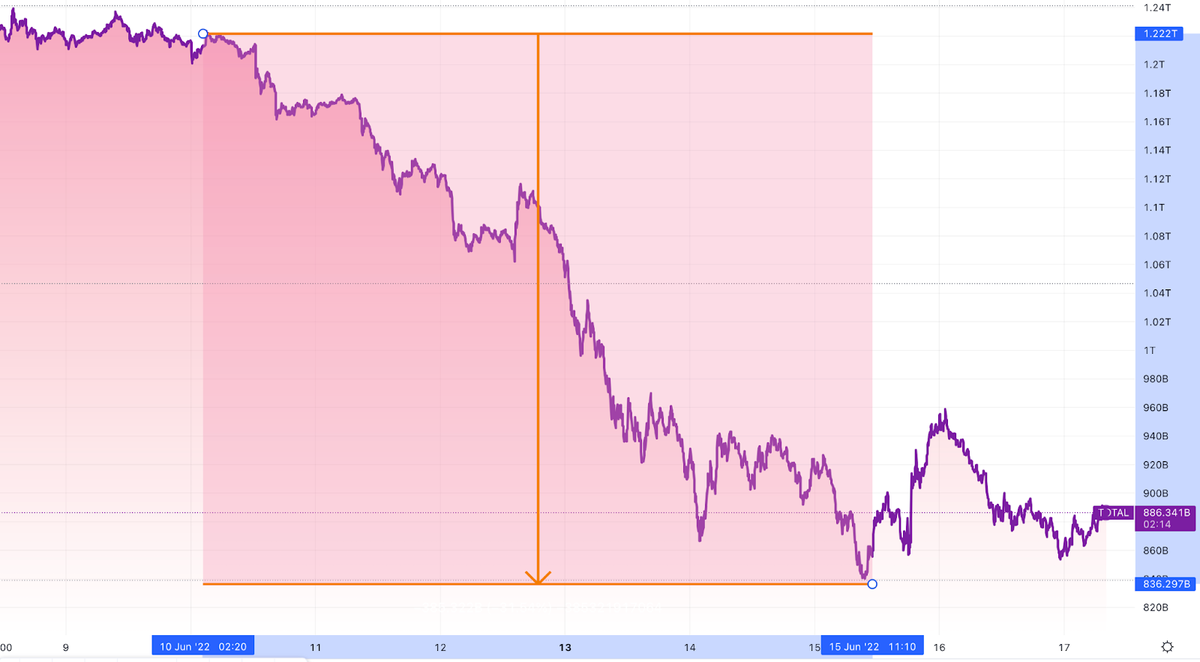The Derivatives Magazine #6

The market continued its decline last week. It started with a problem report from major liquidity provider Celsius and affected many companies with a similar business profile. This included a margin call and liquidations of one of the largest funds, 3 Arrow capital and its venture capital arm Defiance Alliance. Spurred by falling exchange rates, the forced liquidation has led to significant capital outflows, and the cryptocurrency market capitalisation has fallen to relatively below 1 trillion. At low levels, 836 billion corresponded to Bitcoin below 18 000 and less than 900 per Ether. The 3AC situation is structurally similar to the story of Bill Hwong’s Archegos Fund from the traditional financial market, which also led to the forced liquidation of significant positions in Asian equities.
According to Coinglass analytical service the volume of liquidations last week amounted to more than 2 billion USD. Monday June 13 was the most massive one in terms of liquidations, with forced closures amounting to more than USD 770 million. Significant amounts of forced sales also take place across the OTC market. According to Cumberland, one of the largest liquidity providers and OTC operators, the trading volume increased by 30% above the May annual highs due to a large number of forced sales by large corporate borrowers.
Globally, the funding rates of the perpetual futures markets have reduced the spread size compared with the previous reporting period. However, arbitrage opportunities still remain – the difference between open-ended swaps on Bitmex and Okex was as high as 21 percentage points.
Futures trading shows a slowdown in growth dynamics, having reached a certain plateau level. A slight decrease (within 6%) for short-term contracts with execution date of June 24 is largely due to liquidation of short-term positions on increased volatility last week. Also worth noting is the significant increase in trading volume for long-term contracts on the Derebit exchange (with an execution date of March 31, 2023). At a time of huge (over 40%) market declines in recent weeks, participants are seeking to lock in achieved price levels, following a strategy of expected market recovery next year, which could potentially coincide with a cycle of central bank refinancing rate stabilisation and allow new liquidity to flow into the crypto market.
The amount of open positions on the futures market continues to fall, following the fall in BTC on the spot markets. However, there was an explosive increase in trading volume, which coincided with sharp price movements and amounted to more than USD 100 billion per day at the highs.
.The ETH futures market has been under pressure throughout the past week, as well as the spot market price. A similar dynamic to BTC, where a decline in open interest accompanied by an increase in trading volume (to a high of 70 billion) underlines the derivatives’ importance as a tool to maximise profits and control risk in times of high volatility.
Trading flows have changed significantly recently. First, Bitcoin inflows to public exchange addresses have reversed to outflows, with withdrawals at annual highs. Second, recent events with the collapse of the Luna ecosystem, subsequent collateral problems with large liquidity providers and centralized deposit companies have led to the withdrawal of stablecoins from the market – a net outflow was approximately USD 9 billion. In addition, the proportion of the stablecoin market has changed, with the USDT amount dropping significantly and the USDC share rising.
The changes currently taking place in the market definitely have an internal cause as well as an external one. The impact of central bank decisions and the launch of the rate hike cycle is putting pressure on the cryptocurrency market and reducing liquidity due to higher cost of capital. However, behind these macro factors we can see underlying tectonic changes in the capital market order of the past two years. Leading companies are changing, owners of crypto assets are changing. Not all the big “whales” will survive the turbulence this summer. That said, there are plenty of experienced and professionally mature market participants with significantly more liquidity than in the last bear cycle. If no new capital inflows from traditional markets expected, the crypto market will have to rely on internal drivers and use its own reserves to stabilize prices and consolidate trading ranges. All the conditions for this are in place.
This overview was prepared by the analytics department of the Biqutex crypto derivatives exchange



